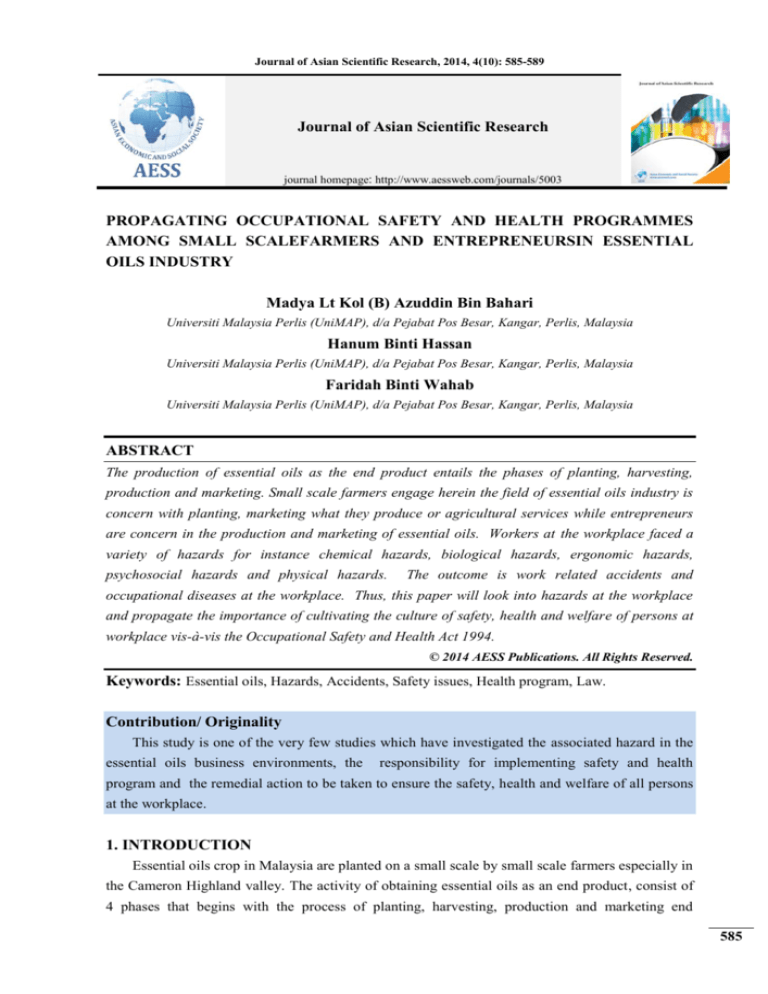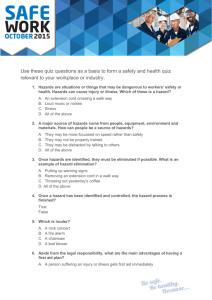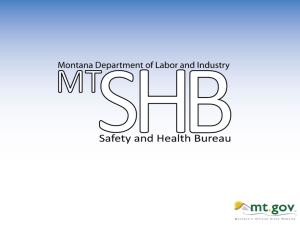
Journal of Asian Scientific Research, 2014, 4(10): 585-589
Journal of Asian Scientific Research
journal homepage: http://www.aessweb.com/journals/5003
PROPAGATING OCCUPATIONAL SAFETY AND HEALTH PROGRAMMES
AMONG SMALL SCALEFARMERS AND ENTREPRENEURSIN ESSENTIAL
OILS INDUSTRY
Madya Lt Kol (B) Azuddin Bin Bahari
Universiti Malaysia Perlis (UniMAP), d/a Pejabat Pos Besar, Kangar, Perlis, Malaysia
Hanum Binti Hassan
Universiti Malaysia Perlis (UniMAP), d/a Pejabat Pos Besar, Kangar, Perlis, Malaysia
Faridah Binti Wahab
Universiti Malaysia Perlis (UniMAP), d/a Pejabat Pos Besar, Kangar, Perlis, Malaysia
ABSTRACT
The production of essential oils as the end product entails the phases of planting, harvesting,
production and marketing. Small scale farmers engage herein the field of essential oils industry is
concern with planting, marketing what they produce or agricultural services while entrepreneurs
are concern in the production and marketing of essential oils. Workers at the workplace faced a
variety of hazards for instance chemical hazards, biological hazards, ergonomic hazards,
psychosocial hazards and physical hazards.
The outcome is work related accidents and
occupational diseases at the workplace. Thus, this paper will look into hazards at the workplace
and propagate the importance of cultivating the culture of safety, health and welfare of persons at
workplace vis-à-vis the Occupational Safety and Health Act 1994.
© 2014 AESS Publications. All Rights Reserved.
Keywords: Essential oils, Hazards, Accidents, Safety issues, Health program, Law.
Contribution/ Originality
This study is one of the very few studies which have investigated the associated hazard in the
essential oils business environments, the
responsibility for implementing safety and health
program and the remedial action to be taken to ensure the safety, health and welfare of all persons
at the workplace.
1. INTRODUCTION
Essential oils crop in Malaysia are planted on a small scale by small scale farmers especially in
the Cameron Highland valley. The activity of obtaining essential oils as an end product, consist of
4 phases that begins with the process of planting, harvesting, production and marketing end
585
Journal of Asian Scientific Research, 2014, 4(10): 585-589
products of essential oil [1]. Small scale farmers engage herein the field of essential oils crop is
concern with planting, marketing what they produce or agricultural services while entrepreneurs are
concern in the production of essential oils. To implement the aforesaid activities, workforces and
machinery are essential element at the workplace. Hence, from planting phase till the production
phase, workers at the workplace of the essentials oils business faced a variety of hazards
(mechanical, electrical, biological, chemical, ergonomics and psychological hazards) and in
addition the obvious unsafe act and unsafe work conditions [2]. The outcome is work related
accidents and diseases prevail at the workplace. Thus, both the employer and self employed
employer have to provide basis requirements in respect of safety, health and welfare of their
employees as specify in the Occupational Safety and Health Act 1994.
1.1. Objectives of Study
The objective of the paper is to highlight the associated hazard in the essential oils business
environments and the remedial action to be taken to ensure the safety, health and welfare of all
persons at the workplace
1.2. Problem Statement
Workforces and machineries at the workplace are the ingredient for the production of essential
oils. A high rate of industrial accident was reported to occur among farmers and workers engage in
this aforesaid field. The main causes of accidents are caused by steam hazards, workplace
transportation accidents, falling from height, agricultural machinery, noise, exposure to dangerous
substance etc. The reason for the said accident at the workplace is because most employers and
small scale farmers of essential oils business was said to put less emphasis on the workers’ health
and safety issues [2] Does it indicate that the laws which are currently put in force are ineffective?
The laws spell out the responsibilities of both employers and employees with regards to the
implementation of a favorable work environment. However, some of the frequently heard reasons
for non compliance to the laws as expressed by both the employer and employees are:
a.
Employers who alleged are not aware of the law with regards to the occupational
safety and health matters and also feel occupational safety and health matters are
not important and have no time to think about such matters and do not have
enough allocation of funds on the issue.
b.
Employees on the other hand said that they are not aware of the safety rules and
regulations in force. The employees too have the notion
that complying with
some of the rules and regulations causes discomfort and are also difficult to
follow
2. LITERATURE REVIEW
The work of obtaining essential oils as an end product varies from wholly mechanized to the
manually strenuous labour. Conversely agricultural work is associated with a variety of safety and
health problems. Working environment at the workplace entail exposure to the physical hazards of
586
Journal of Asian Scientific Research, 2014, 4(10): 585-589
weather, terrain, fire and machinery; toxicity of pesticides, fertilizer and fuel; and health insults
dust [3].
Statistic from SOCSO (Social Security Organization) Malaysia on workplace accident in 2012
indicate that there 61,552 [4], reported cases.
Agriculture ranks among the most hazardous
industries in Malaysia. In 2012, there were 2,267 reported accidents in the agricultural sector in
Malaysia. Farmers are at very high risk for fatal and nonfatal injuries. In United States for example,
in 2010, there were 476 [5] farmers and farm workers who died from a work-related injury,
resulting in a fatality rate of 26.1 deaths per 100,000 workers.
2.1. Safety and Health Issue at the Workplace
From Planting Phase till the Production Phase, those who are involve in the essentials oils
business faced a variety of hazards which lead to workplace accidents and occupational diseases. In
the Planting Phase of Essential Oil Crops, the activities include planting or sowing of crops;
fertilizers application; spraying of pesticides; weeding; watering and irrigation; and compound
maintenance.
Source of hazard are:
a.
Physical hazard such as unsafe tools and equipment, uneven surfaces, fatigue, noise,
dust, vehicles, exposed moving machinery parts and obstacles etcetera.
b.
Biological hazard such as plant allergy, hazardous substances, insects and snakes
etcetera.
c.
Ergonomic hazard such as inappropriate use of tools/equipment, poor manual
handling, environmental etcetera.
d.
Psychological hazard such as dealing with emergencies, working alone and isolation
etcetera
In the Harvesting Phase Essential Oil Crops, the activities include harvest of essential oils crop
manually or using machinery; collecting or gathering of the yield; sending yield for processing for
essential oils product; preparation of machinery, tools and equipment for harvesting and compound
maintenance. Source of hazard inherence may include physical hazard, biological hazard,
ergonomic hazard and psychological hazard.
In the Production, Essential oils are generally extracted through steam distillation, chemical
extraction or CO2 extraction [6],[1]. Potential source of hazard are:
a. Physical hazard such as sharp point and edges, overload or force tools beyond its
capacity, electrical cord insulation damaged, machinery without proper guard
b. Chemical hazard such as exposed to carcinogen chemicals, gases, vapors, fumes,
sanitizers and corrosive chemicals
c. Ergonomic hazard such as wrong design work station, tools and task, repeated
exposure to unnatural movement
d. Biological hazard such as plant allergy, hazardous substances, insects, snakes
e. Psychological hazard such as dealing with emergencies, working alone and isolation.
587
Journal of Asian Scientific Research, 2014, 4(10): 585-589
In the Marketing Phase activities include promotion and advertisement; distribution and
selling. Selling Essential Oils although the most beneficial oils but can prove harmful under certain
condition of usage since it is Photo toxicity, Sensitization and Dermal Irritation.
2.2. Remedial Action
Responsibility for safety and health in the workplace lays with those who create the risks
(employers) and those who work with the risks (employees). The employer and self employed
employer have to provide basis requirements in respect of safety, health and welfare of their
employees as specify in the Occupational Safety and Health Act 1994 so as to solve or minimize
the safety and health issues in the Essential Oils Business Environments. This requirement is stated
in Part IV of the Occupational Safety and Health Act 1994 under the theme “General Duties of
Employers and Self Employed Persons to Their Employees”. The duties of the Employers and Self
Employed Persons to Their Employees are highlighted in Section 15, Section 16, Section 17 and
Section 18 of the said Act.
Hence, some of the Occupational Safety and Health Programs that can to be implemented at
the workplace as follows: [7-10]
a.
Carry out hazard identification, risk assessment and risk control (HIRARC) at the
workplace so as to determine action to address hazard through the process of
Eliminate, Substitute, Isolate, Engineering Control, Administrative, or usage of
Personal Protective Equipments.
b.
Provide occupational safety and health education especial on the need to wear
personal protective equipment during work activities.
c.
Provide safety training to workers at workplace
d.
Conduct medical surveillance and medical examination on a regular basis on
employees so as to guarantee a healthy workforce at the workplace.
e.
Substance use for work is safe and without risks to health
f.
Employers have to establish communication channels to enable the workers to
communicate with regards to Occupational Safety and Health agenda at the
workplace.
3. CONCLUSION
The paper has identified the profiles of the Essential Oil business environment and its
inherence issue of occupational safety and health at the workplace. To have an efficient safety and
health system at the workplace, both the employers and the employees have got to play their roles
and responsibility as required by the Occupational Safety and Health Act 1994 The focus of
occupational safety and health is towards elimination of condition which will cause injury and
occupational diseases at the workplace. Hence, Occupational Safety and Health Programs must to
be implemented at the workplace by the employers.
588
Journal of Asian Scientific Research, 2014, 4(10): 585-589
4. RECOMMENDATION FOR IMPROVEMENT
Based on the discussion aforesaid, to enhance the safe and healthy workplace the following
measures are suggested:
a.
Intensification of drive to enhance awareness and education programs on safety and
health at workplace by the employer towards employees.
b.
Intensification of drive to propagate and instill awareness on laws at workplace,
chemical hazards through Special training courses for employees at workplace.
REFERENCES
[1]
A Guide to Essential Oil Crops, "Department: Agriculture, forestry and fisheries Republic of South
Africa." Available http://www.daff.gov.za/docs/Brochures/guideessoilcrops.pdf, 2012.
[2]
International Lanour Organization, "You health and safety at work, introduction to occupational
health and safety." Available: http://actrav.itcilo.org/actrav-english/tekearb/osh/intro/introduc.htm
[Accessed 4 Sept 2014], 2014.
[3]
M. L. Myers, "Jeanne mager stellman, health problems and disease patterns in agriculture," ILO
Encyclopaedia of Occupational Health and Safety. Available http://goo.gl/6G86Un, 2011.
[4]
SOCSO
(Social
Security
Organization),
"Annual
report,"
p.
211.
Available:
http://www.perkeso.gov.my/images/Laporan_Tahunan_2012.pdf, 2012.
[5]
Agricultural Safety, Available http://www.cdc.gov/niosh/topics/aginjury/, 2014.
[6]
D. S. AtulKatiyar and B. N. Mishra, "Essential oil: Production for health care in current scenario
annals of biological research." Available http://scholarsresearchlibrary.com/archive.html, 2010.
[7]
T. Tom La and J. M. Mendeloff, "Mandatory workplace safety and health programs:
Implementation, effectiveness, and benefit-cost trade-offs," Rand Corporation. Available:
www.rand.org/content/dam/rand/pubs/technical.../RAND_TR604.pdf, 2008.
[8]
Randy
Oglesby,
"Elements
of
an
effective
safety
program."
Available
http://www.amicentral.org/Loss%20Control/reference/safety%20Program%20(Elements%20of%20
an%20Effective).pdf , 2014.
[9]
B. Azuddin, H. Hanum, and J. Ishak, Sustainable occupational safety and health at the workplace.
Kangar: Penerbitan Universiti Malaysia Perlis. ISBN 978-967-5415-61-6, 2013.
[10]
B. L. Roger, Safety and health for engineers, a, 2nd ed. Tolono, Illinois: John Wiley & Sons, Inc.,
Publication, 2006.
589






